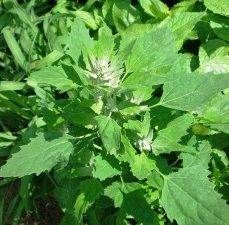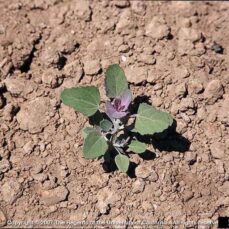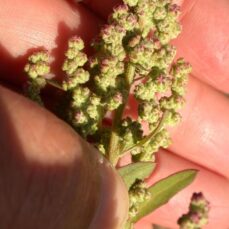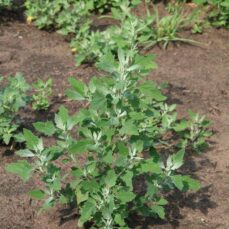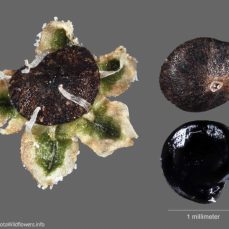
Management Category
Squamish
Whistler
Pemberton
Vectors of Spread
Synonyms
- Pigweed
- White goosefoot
- Wild spinach
ID Characteristics
General: Annual plant in the amaranth family (Amaranthaceae).
Flowers: Tiny, greenish flowers that form dense clusters or spikes at the stem tips and in the leaf axils (where the leaf and stem connect).
Stems: Mature plants range from 0.2 – 2.0 m in height. The stems may be branched or not; they are smooth and green, and may have reddish stripes and ridges that run along the stems’ length.
Leaves: Highly variable due to multiple subspecies. Seedling leaves are egg-shaped, whereas adult leaves can be diamond, egg or lance-shaped. The underside of the leaves are pink in seedlings, and purplish in mature plants. Leaves look greyish-green due to the presence of tiny white hairs which give the leaves a mealy appearance. Leaves are between 3 – 10 cm long and are odourless when crushed.
Fruits: Small black shiny seeds, 1 – 1.5 mm in diameter, are enclosed in a thin, smooth whitish pericarp (thin seed casing). The pericarp is lost when seeds dry.
Roots: Short, branched taproot.
Similar Species
Native

Narrow-leaved Goosefoot (Chenopodium leptophyllum) by Oregon Flora
Narrow-leaved goosefoot (Chenopodium leptophyllum) appears nearly identical to lamb’s quarters as both come from the same genus. Narrow-leaved goosefoot differs by being covered with narrow, linear, single-veined leaves.
Exotic

Common Orach (Atriplex patula) by J. Lehmuskallio
Common orache (Atriplex patula) has an opposite arrangement of the first several pairs of leaves and branches. Also, the leaf base has a lobe on each side.
Habitat and Origin
Native to Eurasia, lamb’s quarters was a commonly eaten green in spring and summer. Prepared as a tea, it is used to treat gastrointestinal tract disorders. It has now become widespread throughout much of North America.
Lamb’s quarters doesn’t tend to invade well-established native plant communities, preferring instead to grow in disturbed sites. Due to its preference for nitrate rich soils, lamb’s quarters often grows on cultivated land. It can be found in gardens, croplands, old fields, weedy meadows, roadsides, and railways.
How it Spreads
Lamb’s quarters reproduces by seed. Each plant produces about 72,000 seeds, which can remain dormant in the soil for 20 years or more.
Lamb’s quarters spreads due to its high rate of seed production. It is also a common contaminant in grass seed. It can be spread through human activity, gardens, and farm cultivation.
Impacts
Health:
- Causes sickness and death in humans and animals if ingested in large quantities.
Ecological:
- One of the most competitive, abundant broadleaf weeds on farmed land in BC.
Economic:
- Reduces crop yields significantly.
Prevent the Spread
Lamb’s quarters is found in the Sea to Sky region and its distribution is beyond landscape-level control. When lamb’s quarters is present at high-priority locations and negatively impacting them, their control is considered a high priority.
Otherwise, the goal is to prevent it from spreading to new (uninfested) areas, and to control it where possible to limit its impact on biodiversity.
Learn to identify lamb’s quarters: use the images presented in this profile page to learn how to identify lamb’s quarters.
What to do if you spot it: You can report any lamb’s quarters sighting by clicking here.
DO:
- Regularly monitor properties for weed infestations.
- Ensure soil and gravel are uncontaminated before transport.
- Check wildflower mixes to ensure that they do not contain lamb’s quarters.
- Ensure that plants are disposed of in a garbage bag if found in floral arrangements to prevent seeds from spreading.
DO NOT:
- Do not unload, park or store equipment or vehicles in infested areas; remove plant material from any equipment, vehicles, or clothing used in such areas and wash equipment and vehicles at designated cleaning sites before leaving infested areas.
- Do not plant lamb’s quarters in a garden, no matter how well-contained its enclosure may seem.
- Do not move soil that has been contaminated with lamb’s quarters.
- Do not compost.
Control
Mechanical
- Lamb’s quarters has a short taproot and can be hand-pulled easily.
- Regular mowing/tilling before the plant goes to seed will reduce weed progression; if flowers have not yet emerged, plant material can safely be left on site to decompose.
- In the post-flowering stage, all plant parts must be bagged and deeply buried at the landfill.
Chemical
- Lamb’s quarters can be controlled through herbicide in most crops.
- Pre-emergent herbicides are recommended. Fluroxypyr with MCPA and fluroxypyr with 2,4-D are identified as effective herbicides for this plant.
- It is worth noting that some lamb’s quarters populations are resistant to Group 5 and Group 2 herbicides.
- Any herbicide applications must be applied through a certified pesticide applicator. We recommend that any herbicide application is carried out by a person holding a valid BC Pesticide Applicator Certificate. Before selecting and applying herbicides, you must review and follow herbicide labels and application rates; municipal, regional, provincial and federal laws and regulations; species-specific treatment recommendations, and site-specific goals and objectives.
Biological
Field mice, sowbugs, millipedes, crickets, slugs, and carabid beetles feed on seeds lying on the soil surface, though they don’t offer significant control.
B.C. Distribution
Lamb’s Quarter Factsheet
Having trouble viewing the factsheet? Don’t worry, all the information is included on this page. You can also contact us with any questions.
References
- Eat The Invaders, Lamb’s Quarters
- Edible Wild Food, Lamb’s Quarters
- Electronic Atlas of the Flora of BC, Lamb’s-quarters
- Electronic Atlas of the Flora of BC, Narrowleaf Goosefoot
- Government of BC, “Lamb’s-quarters” in Guide to weeds in British Columbia (2002),
- Manitoba Agriculture and Resource Development, Lamb’s Quarters
- Mayernik Kitchen, Lambs Quarters
- Michigan State University, Common Lambsquarters
- Michigan State University, 2017 Weed Control Guide for Field Crops
- Minnesota Wildflowers, Lamb’s-quarters
- Ontario Ministry of Agriculture, Food, and Rural Affairs, Ontario Weeds: Lamb’s quarters
- Top Crop Manager, Solving the problem of lamb’s quarters
- Yukon Conservation Data Centre, Narrowleaf Goosefoot





